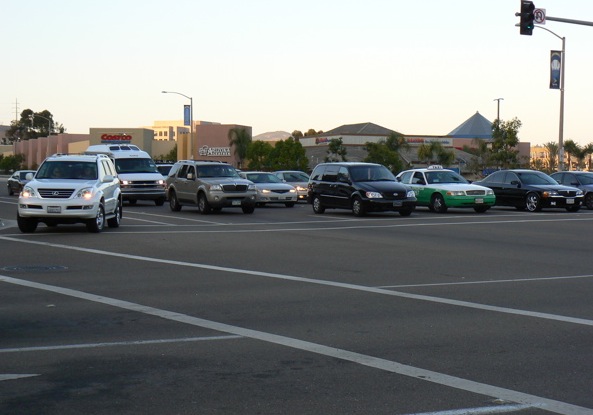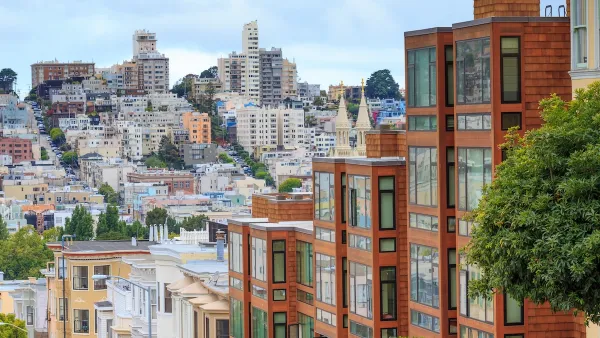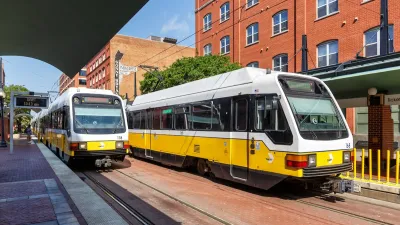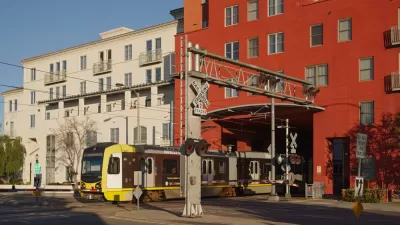The common wisdom about walkable neighborhoods holds that density – proximity to destinations – determines the number of walking trips. An ideal walking distance of a quarter mile is usually prescribed between residences and the nearest transit stop or retail center. I don’t dispute that walking distance is important, especially when I’m lugging an armload of groceries. However, some trendy high-density development favors compactness at the expense of comfort and safety.
The common wisdom about walkable neighborhoods holds that density – proximity to destinations – determines the number of walking trips. An ideal walking distance of a quarter mile is usually prescribed between residences and the nearest transit stop or retail center.
I don't dispute that walking distance is important, especially when I'm lugging an armload of groceries. However, some trendy high-density development favors compactness at the expense of comfort and safety.
An award-winning transportation research paper found that pedestrians typically walked farther than they thought to reach a transit stop: a half mile instead of a quarter mile. It also cited an absence of barriers as a major factor in the decision to walk. In my opinion, such barriers, both physical and perceived, are a stronger deterrent for pedestrians than distance. They include dangerous intersections, isolated or unsafe areas, high traffic density, parking lots, narrow sidewalks and poor lighting. If a route is pleasant and obstacle-free, pedestrians may well underestimate the time and distance of their trips.
Several new housing developments in my city are built literally within a few hundred yards of a shopping mall. But all of these dense, "mixed-use" housing-and-shopping pairs are bisected by major roads, requiring residents to cross multiple lanes of traffic in order to access shopping. (Worse, there are no grocery stores to be found, just warehouse retail. Would you walk to Costco?)
Most people are willing and able to walk more than a quarter mile; people who prefer walking would like to have the space to move. Time and distance are certainly an issue for hurried commuters, for the elderly or disabled, and during extreme weather. Still, a commute on foot can be a good replacement for a daily workout, especially when so many commuters today are sitting in their cars for hours, stuck in traffic. I have comfortably walked a few dozen blocks in New York City, but I would rather drive across the street in the neighborhood pictured above. If good urban planning is supposed to promote an active lifestyle, I wouldn't call walking 100 yards across a smoggy intersection active or healthy.

Maui's Vacation Rental Debate Turns Ugly
Verbal attacks, misinformation campaigns and fistfights plague a high-stakes debate to convert thousands of vacation rentals into long-term housing.

Planetizen Federal Action Tracker
A weekly monitor of how Trump’s orders and actions are impacting planners and planning in America.

In Urban Planning, AI Prompting Could be the New Design Thinking
Creativity has long been key to great urban design. What if we see AI as our new creative partner?

Portland Raises Parking Fees to Pay for Street Maintenance
The city is struggling to bridge a massive budget gap at the Bureau of Transportation, which largely depleted its reserves during the Civd-19 pandemic.

Spokane Mayor Introduces Housing Reforms Package
Mayor Lisa Brown’s proposals include deferring or waiving some development fees to encourage more affordable housing development.

Houston Mayor Kills Another Bike Lane
The mayor rejected a proposed bike lane in the Montrose district in keeping with his pledge to maintain car lanes.
Urban Design for Planners 1: Software Tools
This six-course series explores essential urban design concepts using open source software and equips planners with the tools they need to participate fully in the urban design process.
Planning for Universal Design
Learn the tools for implementing Universal Design in planning regulations.
Gallatin County Department of Planning & Community Development
Heyer Gruel & Associates PA
JM Goldson LLC
City of Camden Redevelopment Agency
City of Astoria
Transportation Research & Education Center (TREC) at Portland State University
Jefferson Parish Government
Camden Redevelopment Agency
City of Claremont






























